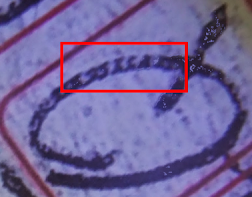THE BATTLEFRONT & THE PLAYERS
PART 1.
This is a Battle map that shows the situation on Australian's Northern flank, it is of course centered on New Guinea and the islands from Guadalcanal up to Rabaul and the Admiralty Islands, Manus and then through Rabaul to Buna, Kokoda, and Port Moresby not forgetting Milne Bay.
How does this map have anything to do with the Somerton Man case? Well, from where I sit it seems to me that a lot of players in the case at one time or another spent part of their lives here.
Not only people are involved, so are vessels. It's these vessels plus the people that Clive and I have been researching and quite thoroughly and we based the research on what was found in the letter Q on the code page:
 |
| In this image the focus is directly on the XCA sequence |
J232 X RAN X 35 X CA25 or CA35
We have been able to identify two vessels and possibly a third that we can tie directly to the case. It's the knowledge of just where those vessels were deployed and from where they may have been viewed that could hold the key to unlocking the code page.
The year in focus is 1944 and the vessels are:
1. HMAS Deloraine, a Corvette (minesweeper) Hull number J232, (This ship was also known as M232) We do not have its Radio call code as yet:
STATUS
The HMAS Deloraine we are quite certain about and are of the belief that one of the 2 USS Vessels is also very relevant in this research.
At a point in time, HMAS Deloraine and one of the other two vessels were in close physical proximity to each other, close enough to be visible to someone who could have been:
1. On one of these named ships
2. On yet another ship
3. Or perhaps on a shore base.
Whichever it was, that person recorded viewing the Deloraine and one of the other two ships at or around the same time and date and entered the Hull number in microcode into the letter Q on the SM code page.
Apart from the vessels, we have two people in mind at this stage and whilst we can place one of them directly in the area, the other is more problematical.
We are working on a time-based matrix that should show us just which of these two men fit the profile. To make it extra interesting, it's not beyond the realms of possibility that both men will fit.
For all the keen researchers out there, finding a crew list for the Deloraine might be useful.
COASTWATCHERS
Given the instances of number sets on the code page, many of which begin with the letter X, it could be that what we are seeing are written down Costwatchers frequencies call signs.
We are working on a time-based matrix that should show us just which of these two men fit the profile. To make it extra interesting, it's not beyond the realms of possibility that both men will fit.
For all the keen researchers out there, finding a crew list for the Deloraine might be useful.
CALL SIGNS
All sea vessels had fixed radio call signs and whilst we currently have the call signs/codes for both US ships, tracking down the RAN equivalents is proving something of a challenge although I think we're now in touch with the right people.
Radiocommunications played a very large part in the winning of the Battle of the Coral Sea and others, The US, in particular, relied heavily on its use with some VT, Visual transmission, used as a backup, I am sure most would be familiar with the often seen shipboard 10 inch Aldis lamp
COASTWATCHERS
Off the Northern shores of Australia and right throughout the huge number of islands in the South Pacific, there was a network of Coastwatchers, in fact in an earlier post I had the great privilege of speaking with one of their number. As a result of that discussion I followed up at the time and found that the frequency used by Coastwatchers was in the 6 mhz band, the individual frequencies were known as X Frequencies.
Given the instances of number sets on the code page, many of which begin with the letter X, it could be that what we are seeing are written down Costwatchers frequencies call signs.
https://www.ozatwar.com/sigint/crs.htm
The Coastal Radio Stations at Darwin, Thursday Island, Townsville, Port Moresby, and Rabaul assisted the RAN Coast Watching scheme. They received and relayed information about the enemy military activity to and from Coast Watchers who operated behind Japanese lines. These Coastal Radio Stations had a dedicated receiver constantly tuned to a particular frequency in the 6 MHz band, which was known as "X" frequency. The Coast Watchers used Teleradios which were fitted with specially cut crystals which operated on this same frequency. The "X" frequency receivers at the Coastal Radio Stations were left on loudspeaker 24 hours a day to ensure all messages were heard.
USS INDIANAPOLIS
I should note that the USS Indianapolis has a very special place in history, just days after it had broken a speed record for a dash from San Diego to Hawaii with some highly classified cargo (enriched uranium) related to the Manhattan Project, it was torpedoed by a Japanese submarine resulting in a massive loss of life. For those interested, more than 1500 photographs of the ship, equipment, maps, and its crew survived the episode. It's a story well worth reading and you will find more here.Paul Allen, the joint Microsoft founder, led the recovery team that eventually found the wreck of the Indianapolis in 5500 meters of water in the North Philipines Sea in August 2017.


















